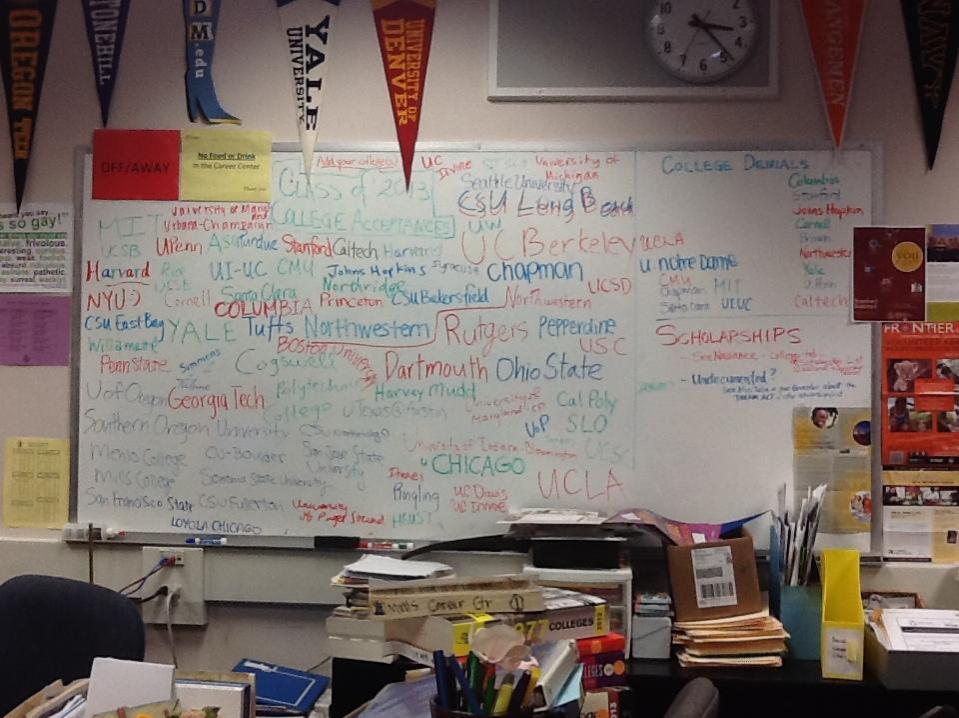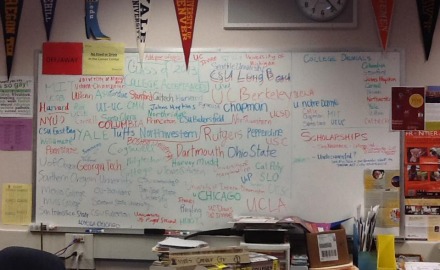After failed attempts at creating a wall of college rejection letters at MVHS, college denials are now documented alongside college acceptances.

Each fall for the past seven years, the whiteboard in the Career Center has become progressively less white every fall as seniors fill the board with the names of the colleges they have been accepted to in colorful ink. This year, the board looks ready to explode with colleges — Cogswell, Harvard, Ohio State, UC Berkeley and a myriad of others.
However, this year, Career Center Liaison Miriam Taba added a twist to her whiteboard record of college admissions. She has separated a sixth of the board from the jumble of college acceptances and has titled it “College Denials.” Whereas the majority of the college acceptances list was filled by students, Taba has taken entries for the denial list via word of mouth and has added the colleges to the list herself. Yet just as with the acceptances list, she has not used Naviance to verify or post colleges on the list. As of now, the number of college denials listed is much smaller than that of college acceptances.
“Why not be realistic,” Taba said. “For everyone who put an acceptance up, I figured there’s a student who didn’t get accepted. And I want people to know, ‘Hey, it’s okay not to get accepted.’”
Taba strongly supports the idea of a rejection wall (where students would post copies of their rejection letters) as a way to deal with the hard feelings that often accompany denials. According to Taba, counselors she met from other schools at counselors’ meetings have said that posting copies of students’ rejection letters was successful for them. Having such a wall would allow students to feel better about getting denied because there are plenty of others, including top students in the same boat. Some schools, Taba says, even have rejection letter burnings.
“Some get in; some don’t get in,” Taba said. “It has to do with what colleges are looking for this particular day. If they need a left-handed tuba player this year and you’re a left-handed tuba player, guess what? You’re going to have an advantage over somebody who’s not! And we have no control over that.”
As for a rejection wall at MVHS, there have been a number of student attempts that were shut down by the administration. According to assistant principal Brad Metheany, having a rejection wall “is not appropriate,” as it encourages a “mob mentality” where students unneccessarily get riled up at the “injustice” done by colleges to those who were rejected.
Senior Michelle Tsai does not see such a wall as inappropriate; she sees it as pointless.
“If it’s for informative purposes, I don’t think it wouldn’t help because the underclassmen would have to know about the statistics for the rejected person to benefit,” Tsai said. “If seniors voluntarily want to [participate], I am all for it because it’s their freedom of choice. I just don’t get why they would do it, especially if it was a family legacy, and they failed the family. The mocking would only escalate.”
One attempt at establishing a rejection wall at MVHS occurred in March 2010 when Class of 2010 alumnus Naicheng Wangyu, at that time a senior, submitted a motion to ASB to start a physical wall of rejection letters. Although the motion was passed March 23, 2010, the administration struck it down. Wangyu and his friends made do with a virtual rejection wall on Google Docs, accessible to seniors through School Loop. It was available for two and a half weeks. Around one hundred seniors responded.
The Dean of Students in 2010, Denae Moore, voiced the administration’s concerns in having a rejection wall in an interview with former reporter and Class of 2010 alumna Somel Jammu for the print article “Rejected” that was published in the April 2010 issue of El Estoque.
“It’s not a good perception of the school if someone sees all this rejection going on,” Moore said. “I think we should really be focusing on celebrating our successes, not advertising our failures — or, ‘perceived’ failures.”
Metheany concurs with Moore’s statement, although he denies that the reason for turning down a proposed rejection wall was not to uphold the school’s image.
“We have so many positive things to celebrate,” Metheany said. “We are one of the best public high schools in the country. We don’t need to give time to negative energy. It’s not worth our time.”
Taba has not received any official response from the administration or from students about the denial list and is unsure of how many people noticed the denial list at all. Metheany, although he understands the potential therapeutic effects of Taba’s denial list, questions its merit.
“It doesn’t seem too positive,” Metheany said. “That wall space could be used to announce some scholarships.”
Tsai, on the other hand, does not see the denial list as being negative. As with the rejection wall, she believes the denial list is pointless.
“If you’re comforted by the fact that other people got rejected, then I guess that would make you feel better,” Tsai said. “But I don’t understand how it would help seniors. You may find comfort in companionship, but it doesn’t change what happens to you.”














